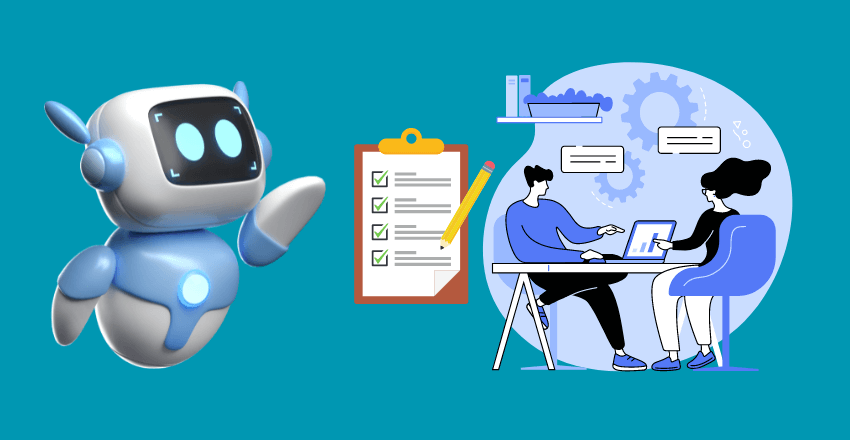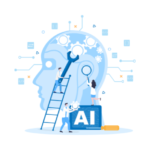 As artificial intelligence (AI) continues to revolutionize the way we live and work, the demand for skilled AI engineers is on the rise. However, hiring the right candidate with the necessary skills and knowledge can be a daunting task for any employer.
As artificial intelligence (AI) continues to revolutionize the way we live and work, the demand for skilled AI engineers is on the rise. However, hiring the right candidate with the necessary skills and knowledge can be a daunting task for any employer.
To help with the hiring process, we have compiled a list of 10 vital interview questions that will assist in evaluating the expertise and technical abilities of AI engineers. These questions have been designed to assess their understanding of AI concepts, problem-solving skills, and technical abilities. By asking these questions, you can determine if the candidate is the right fit for your organization’s needs.
Key Takeaways
- Interview questions for an AI engineer should assess their technical abilities, understanding of AI concepts, and problem-solving skills.
- The questions should cover fundamental AI topics, including machine learning algorithms, neural networks, and performance evaluation methods.
- Asking candidates about their practical experience in working on real-world AI projects can showcase their practical experience and expertise.
AI Engineer Interview Question 1: What are the key components of a machine learning algorithm?
When interviewing an AI engineer, it’s essential to ask technical AI questions that assess their knowledge of machine learning algorithms; one of such questions is, “What are the key components of a machine learning algorithm?
The answer to this question will reveal the candidate’s understanding of the essential elements involved in building an effective AI model. To provide a comprehensive answer, the candidate should mention the following components:
| Component | Description |
|---|---|
| Data | Machine learning algorithms require a significant amount of data for training, validation, and testing. |
| Features | These are the attributes extracted from the raw data that the algorithm uses to make predictions. |
| Model | The machine learning model maps the input data to the output prediction through a mathematical function. |
| Hyperparameters | These are configurations that define how the model learns from the data, such as learning rate and batch size. |
Having a thorough understanding of these components is crucial to design and implement effective AI models. Thus, it is a vital interview question to ask a potential AI engineer.
AI Engineer Interview Question 2: How do you handle overfitting in machine learning models?
Overfitting is a common challenge in machine learning, and it occurs when a model learns the training data too well, leading to poor performance on new, unseen data. During an AI engineer interview, it’s essential to ask candidates how they would handle this problem.
An excellent answer to this question should demonstrate an understanding of the causes of overfitting and the methods for avoiding it. One approach to address overfitting is to use regularization techniques such as L1 and L2, which add a penalty term to the loss function to prevent the model’s weights from becoming too large. Another method is to use early stopping, which halts the training process when the model’s performance on a validation set starts to degrade. A third approach is to use data augmentation, which artificially expands the training set by creating new samples through transformations such as rotations and translations.
Additionally, candidates should be able to explain how they would diagnose overfitting in a model. They may mention using techniques such as cross-validation and learning curves to evaluate the performance of the model on different sets of data. They may also discuss the importance of monitoring the model’s validation performance during training to detect when overfitting occurs.
Overall, asking candidates about their approach to handling overfitting is a vital interview question for AI engineers. It can reveal their technical abilities and problem-solving skills, as well as their understanding of core machine learning concepts. For employers, knowing that an AI engineer has experience with overfitting and strategies to address it can help ensure that the models they develop are robust and reliable.
AI Engineer Interview Question 3: Explain the concept of gradient descent in deep learning

Gradient descent is an optimization algorithm used in deep learning to train neural networks by iteratively adjusting the weights to minimize the loss function. The loss function measures the difference between the predicted output and the actual output. The goal of gradient descent is to find the minimum point of the loss function and adjust the weights of the neural network accordingly.
There are three types of gradient descent: batch, stochastic, and mini-batch. In batch gradient descent, the weights of the neural network are updated after evaluating the loss function on all training samples. In stochastic gradient descent, the weights are updated after evaluating the loss function on one training sample at a time. Mini-batch gradient descent is a compromise between batch and stochastic, where the weights are adjusted after evaluating the loss function on a small batch of training samples.
There are different variations of gradient descent, including momentum, Adagrad, and Adam. Momentum helps to accelerate convergence by reducing the oscillation of the weights during training. Adagrad adapts the learning rate to the parameters of the neural network, with the aim of reducing the learning rate for parameters which have been updated frequently, and increasing the learning rate for parameters which have been updated infrequently. Adam combines the advantages of momentum and Adagrad to improve the convergence of the algorithm.
When preparing for an AI engineer interview, it is important to have a solid understanding of gradient descent and its variations, as well as their advantages and disadvantages. Practice implementing gradient descent in different scenarios to showcase your expertise in this critical optimization algorithm.
AI Engineer Interview Question 4: What are the different types of neural networks?
Neural networks are a fundamental component of artificial intelligence (AI). Understanding the various types of neural networks is critical for an AI engineer when selecting an appropriate model for a specific task. Here we will explore the different types of neural networks that an AI engineer should be familiar with.
The following are the main types of neural networks:
- Feedforward neural networks: This is the most common type of neural network that consists of an input layer, one or more hidden layers, and an output layer. Information flows forward from the input layer through the hidden layers and to the output layer. These networks are often used for tasks such as classification and prediction.
- Recurrent neural networks (RNNs): These neural networks contain loops that allow information to persist. They are often used for understanding sequential data such as language or speech processing and time series prediction.
- Convolutional neural networks (CNNs): These networks are commonly used in image and video processing tasks. They are particularly well suited for recognizing patterns and features in images.
- Generative neural networks: These networks can generate new data using existing data as inputs. They are often used in tasks such as image or music generation.
During an AI job interview, this question will help assess the candidate’s familiarity with different types of neural networks, and their ability to apply them to specific tasks.
AI Engineer Interview Question 5: How do you handle imbalanced datasets in machine learning?
Imbalanced datasets are common in machine learning, where the distribution of classes is uneven. This scenario leads to a model that performs poorly on the underrepresented class. The solution to this problem requires a thoughtful approach during the training phase.
A candidate’s response can reveal their experience and creativity in handling this challenge. One common approach is to use a combination of undersampling and oversampling techniques. Undersampling involves removing some instances from the over-represented class to balance the dataset. Oversampling, on the other hand, duplicates instances from the under-represented class to balance the data.
Alternatively, a candidate may suggest using more sophisticated techniques like Synthetic Minority Over-sampling Technique (SMOTE), which generates synthetic instances of the under-represented class.
Another crucial approach is by adjusting the classification threshold. In some cases, a model may perform well on the overall accuracy metric but fail on the minority class. Adjusting the classification threshold to increase the precision or recall score can improve the model’s performance on the minority class.
Finally, a candidate can also suggest approaching the problem from a different angle, such as modifying the objective function or exploring alternative algorithms.
The answer to this question will showcase the candidate’s technical knowledge, creativity, and problem-solving abilities in handling imbalanced datasets in machine learning. It is a vital interview question that assesses the candidate’s technicality in AI and their ability to handle real-world challenges.
AI Engineer Interview Question 6: Can you explain the concept of backpropagation in neural networks?
Backpropagation is a critical aspect of training neural networks and is the algorithm responsible for updating the weights of a neural network during backpropagation.
The backpropagation algorithm works by first passing an input data point forward through the neural network to generate a predicted output. The difference between the predicted output and the actual target output is then calculated, known as the error. The backpropagation algorithm then works by propagating this error backward through the network, adjusting the weights of each neuron to minimize the error.
This process is repeated for each training data point, with the network adjusting its weights to better fit the training data. Backpropagation is a computationally intensive process, and there are several optimizations that can be used to facilitate this process.
Understanding backpropagation is a vital skill for an AI engineer, as it enables them to train neural networks effectively and optimize their performance. AI engineers must have a strong foundation in the underlying mathematics and concepts of backpropagation to be successful in their roles.
AI Engineer Interview Question 7: How do you evaluate the performance of a machine learning model?

Assessing the performance of a machine learning model is a crucial aspect of an AI engineer’s role. It involves measuring the accuracy and effectiveness of the model in predicting outcomes. There are several evaluation techniques and metrics that an AI engineer should be familiar with to determine the model’s performance.
The most common evaluation metrics for classification models are accuracy, precision, recall, and F1 score. Accuracy measures the percentage of correct predictions made by the model. Precision and recall are calculated by comparing the number of true positives, true negatives, false positives, and false negatives of a model’s predictions. The F1 score is the harmonic mean of precision and recall.
For regression models, the most common evaluation metrics are mean squared error (MSE), root mean squared error (RMSE), mean absolute error (MAE), and R-squared. MSE measures the average squared difference between the predicted and actual values. RMSE is the square root of MSE, while MAE measures the average absolute difference between the predicted and actual values. R-squared is a statistical measure that represents the proportion of variance in the dependent variable that is explained by the independent variables.
An AI engineer should also be knowledgeable in cross-validation, which involves dividing a dataset into multiple subsets to train and test the model on different samples. Cross-validation helps to prevent overfitting and ensure that the model can generalize well on new data.
An AI engineer should be familiar with a range of evaluation techniques and metrics for measuring the performance of machine learning models. Being able to select the appropriate evaluation method for a specific project is critical to build high-quality and accurate AI models.
AI Engineer Interview Question 8: What are the ethical considerations in AI development?
When it comes to AI development, it’s essential to consider the potential ethical implications. As an AI engineer, you must ensure that your work aligns with ethical standards and values. During the interview process, the interviewer will assess your awareness of these ethical considerations and your ability to address them.
One of the most common ethical considerations in AI development is bias. AI models can unintentionally perpetuate existing social biases and discrimination in society, leading to unfair outcomes for certain individuals or groups. As an AI engineer, you must identify and address these biases to ensure that your models are neutral and fair.
Privacy is another important consideration. AI models often require vast amounts of data, including sensitive personal information. You must ensure that this data is collected and used in a responsible manner, with appropriate consent and security measures in place.
Transparency and accountability are also essential in AI development. You must be able to explain how your AI models work and make decisions and be accountable for any errors or negative consequences that arise from their use.
During the interview process, demonstrate your awareness of these ethical considerations and provide examples of how you have addressed them in your previous work. Show that you are committed to upholding ethical standards and values in your role as an AI engineer.
AI Engineer Interview Question 9: How do you stay updated with the latest advancements in AI?
As a rapidly evolving field, staying updated with the latest trends and advancements in AI is crucial for any AI engineer. During the interview process, it’s essential to evaluate a candidate’s commitment to continuous learning and staying up-to-date with emerging technologies.
To assess this, you can ask the candidate about their preferred sources of information, such as industry publications, research papers, or online forums. They should also have a track record of attending relevant conferences, workshops, and training sessions to expand their knowledge.
Another aspect to evaluate is their hands-on experience with new technologies. A candidate who experiments with new tools and implements the latest techniques in their work would be an asset to your team.
A candidate’s response to this question will provide insight into their passion for the field and their willingness to invest time and effort into continuous learning.
An AI engineer should be committed to staying updated with the latest advancements in their field. During the interview, evaluate their preferred sources of information, track record of attending relevant events, and hands-on experience with new technologies.
AI Engineer Interview Question 10: Can you provide an example of a real-world AI project you worked on?
Asking candidates to provide examples of real-world AI projects they have worked on is a crucial interview question that helps assess their practical experience and competence in the field. The answer to this question will provide insight into the candidate’s ability to apply AI concepts in solving complex problems and delivering tangible results.
When answering this question, candidates should be able to clearly explain the project’s objectives, scope, and the AI techniques and tools they deployed. They should also highlight any challenges they faced during the project and how they overcame them. Additionally, the candidate should emphasize the project’s impact, benefits, and outcomes, such as improved efficiency, accuracy, and automation.
By answering this question, the candidate can showcase their technical AI skills and demonstrate their proficiency in building effective AI solutions that deliver real value to the organization. Therefore, this question is a vital part of the interview process, especially for technical AI roles.
Example Answer:
During my previous role as an AI Engineer at XYZ Company, I worked on a project that involved developing an AI-powered chatbot for the customer support team. The objective was to increase customer satisfaction by providing 24/7 support and reducing wait times.
To achieve this, I used natural language processing (NLP) techniques to train the chatbot to understand and respond to customer queries in real-time. I also integrated it with the company’s database to provide personalized solutions to customers based on their past interactions.
The project was not without its challenges, and the primary one was ensuring the chatbot’s accuracy and relevance as customers’ queries were diverse. To overcome this, I employed transfer learning techniques to improve the chatbot’s performance and make it more adaptable to different contexts.
The project was a success, and within three months of deployment, the chatbot had reduced customer wait times by 50%, leading to a 30% increase in customer satisfaction rates. The project also enabled the customer support team to focus on more complex queries, ultimately improving their efficiency and productivity.
External Resources
https://machinelearningmastery.com/smote-oversampling-for-imbalanced-classification/
FAQ

Q: What are the key components of a machine learning algorithm?
A: The key components of a machine learning algorithm include the input data, the model, the loss function, the optimizer, and the evaluation metrics. The input data is the information used to train the model, while the model is the algorithm that learns from the data. The loss function measures how well the model is performing, and the optimizer adjusts the model’s parameters to minimize the loss. Finally, the evaluation metrics are used to assess the model’s performance on unseen data.
Q: How do you handle overfitting in machine learning models?
A: Overfitting occurs when a model becomes too specialized in the training data and performs poorly on unseen data. To handle overfitting, techniques such as regularization, cross-validation, and early stopping can be used. Regularization adds a penalty term to the loss function to discourage complex models, cross-validation helps assess the model’s generalization performance, and early stopping stops training when the model starts to overfit the data.
Q: Explain the concept of gradient descent in deep learning.
A: Gradient descent is an optimization algorithm commonly used in training deep learning models. It involves iteratively adjusting the model’s parameters based on the gradient of the loss function with respect to those parameters. The gradient indicates the direction of steepest descent, and the algorithm follows this direction to find the optimal set of parameters that minimize the loss.
Q: What are the different types of neural networks?
A: There are several types of neural networks, including feedforward neural networks, convolutional neural networks, recurrent neural networks, and generative adversarial networks. Feedforward neural networks are the most basic type and consist of an input layer, one or more hidden layers, and an output layer. Convolutional neural networks are commonly used for image recognition tasks, while recurrent neural networks are suitable for sequence data. Generative adversarial networks are used for generating realistic synthetic data.
Q: How do you handle imbalanced datasets in machine learning?
A: Imbalanced datasets, where the classes are not represented equally, can lead to biased models. Techniques such as oversampling, undersampling, and the use of different evaluation metrics can be employed to handle imbalanced datasets. Oversampling involves duplicating minority class samples, undersampling involves reducing the number of majority class samples, and using different evaluation metrics like precision and recall can provide a more comprehensive assessment of the model’s performance.
Q: Can you explain the concept of backpropagation in neural networks?
A: Backpropagation is the process of calculating the gradients of the loss function with respect to the parameters of a neural network. It allows the network to learn by iteratively updating the weights based on these gradients. The gradients are propagated backward through the network, layer by layer, using the chain rule of calculus. This process enables the network to adjust its parameters in a way that reduces the loss and improves its performance.
Q: How do you evaluate the performance of a machine learning model?
A: The performance of a machine learning model can be evaluated using various metrics, such as accuracy, precision, recall, F1 score, and area under the receiver operating characteristic (ROC) curve. Accuracy measures the overall correctness of the model’s predictions, precision quantifies the ratio of correctly predicted positive instances to the total predicted positive instances, recall measures the ratio of correctly predicted positive instances to the total actual positive instances, the F1 score combines precision and recall into a single metric, and the ROC curve represents the trade-off between true positive rate and false positive rate.
Q: What are the ethical considerations in AI development?
A: Ethical considerations in AI development include issues such as bias and fairness, privacy and security, accountability and transparency, and potential job displacement. AI systems can inadvertently perpetuate biases present in the data used for training, resulting in unfair and discriminatory outcomes. Privacy and security concerns arise from the collection and usage of personal data. Accountability and transparency are important to ensure that AI systems can be audited and understood. Finally, the potential impact of AI on jobs and the workforce should be carefully considered.
Q: How do you stay updated with the latest advancements in AI?
A: Staying updated with the latest advancements in AI involves continuous learning and engagement with the AI community. This can be achieved through reading research papers, attending conferences, participating in online courses and tutorials, following AI experts and organizations on social media, and joining AI-related forums and communities. It is important to stay abreast of new techniques, tools, and applications in order to remain competitive and innovative in the field.
Benjamin Bale is a distinguished expert in the field of AI development and an esteemed author for the “Hire AI Developer” blog. With a remarkable decade-long experience in the industry, Benjamin has cemented his reputation as a leading authority in AI app and website development, as well as AI backend integrations. His profound passion for AI and its transformative potential is evident in every aspect of his work.
Benjamin’s journey into the world of AI began at Edinburgh University, where he pursued his studies in AI and Mathematics. It was during this time that he cultivated a deep understanding and fascination for the subject. Throughout his career, Benjamin has accumulated extensive experience working with industry giants such as Goldman Sachs, Tencent, and Ali Express. These invaluable experiences have not only sharpened his skills in integrating existing systems with AI APIs but have also solidified his status as a consummate professional in the field.
Currently residing in the vibrant city of London, Benjamin finds solace in his role as both an author and developer. Beyond his professional endeavors, he takes great joy in the company of his faithful canine companion, Chad, and indulges his passion for snowboarding in the picturesque mountains of France. Benjamin’s unwavering dedication to advancing AI technology, combined with his wealth of knowledge and practical expertise, make him an invaluable asset to the “Hire AI Developer” team and an invaluable resource for readers seeking profound insights into the realm of AI.







